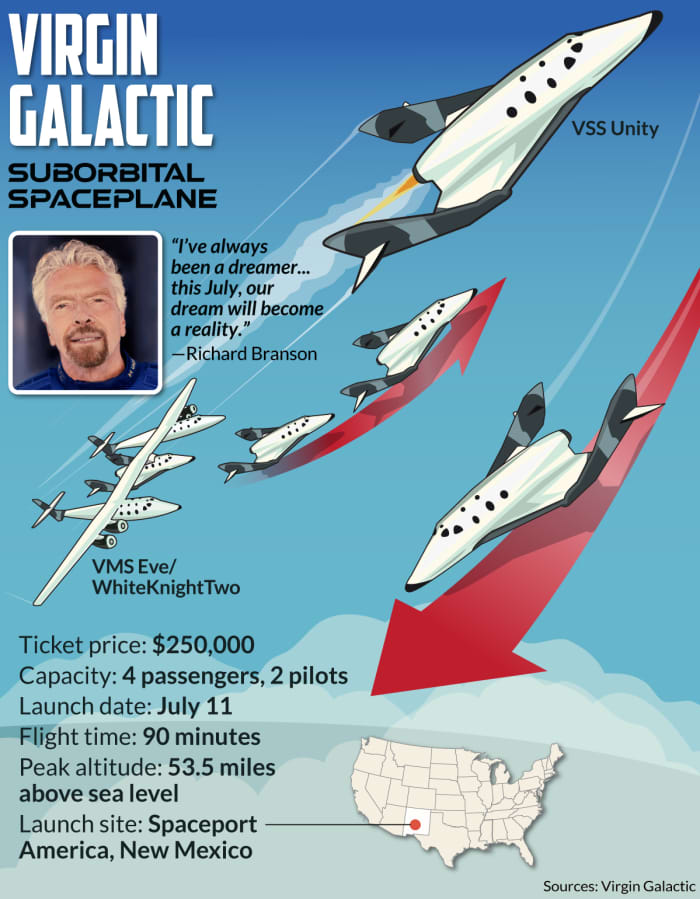This post was originally published on this site
Now it’s Jeff Bezos’s turn to fly to the edge of space.
The billionaire space race enters a new phase this Tuesday, as Jeff Bezos, who recently stepped down as Amazon’s
AMZN,
CEO, blasts off aboard Blue Origin’s New Shepard rocket and space capsule to reach suborbital space. His trip comes just nine days after Virgin Galactic
SPCE,
CEO Richard Branson charted the course with a similar trip aboard his VSS Unity rocket-powered spaceplane.
Both flights have aimed to boldly go where no manned commercial spacecraft have gone before — approximately 55 to 66 miles above sea level, where the passengers can spend a few minutes experiencing weightlessness and enjoying an out-of-this-world view of the curvature of the Earth.
And the launches have a lot in common, which makes comparing them inevitable: both feature world-famous billionaires taking their pet space projects on test drives to the edge of outer space without reaching orbit, paving the way for space tourism’s future. (In fact, more than 700 people, including Tom Hanks, Justin Bieber, Lady Gaga — and even, reportedly, SpaceX founder Elon Musk — have already signed up for seats on future Virgin Galactic flights.)
But there are also a couple of key differences — such as which CEO is actually reaching space first.
Branson, who turns 71 on Sunday, successfully accomplished his mission on July 11. He lifted off from New Mexico aboard a spacecraft attached to Virgin Galactic’s WhiteKnightTwo airplane. The plane — named VMS Eve after Branson’s mother — carried the VSS Unity SpaceShipTwo vehicle up to 45,000 feet before releasing it. Then a pilot fired the VSS Unity’s rockets and flew the ship into suborbital space, reaching a peak altitude of 53.5 miles above sea level.

“The whole thing, it was just magical,” Branson said after landing.
But that might not meet the definition of space for some, since international aeronautic and astronautical organizations in Europe consider the Kármán Line the official boundary of space — and that is actually 62 miles above the Earth. Yet NASA, the U.S. Air Force and the Federal Aviation Administration all say that going above 50 miles counts as kissing outer space. So, by their definition, Branson did indeed earning his astronaut wings, which he received upon his return to Earth.
When Bezos, 57, takes off on the New Shepard from West Texas on Tuesday, however, the fully automated rocket will fly briefly above that Kármán Line. So Bezos is flying higher — but Branson’s trip was longer, as Virgin Galactic’s flights last around 14 to 17 minutes from the time the space plane is released from the mother ship and fires its rocket motor, and the total mission clocks in at around an hour or more. Meanwhile, the Blue Origin’s entire trip, from launch to landing, is expected to last around 11 minutes.
Read more: Jeff Bezos in space: Where is he going, and who else will be onboard the New Shepard?
Plus, Branson went first — although he played down any talk of interplanetary competition in recent interviews. “I know nobody will believe me when I say it, but honestly, there isn’t” a competition, he told NBC.
And Bezos sent his congratulations to Branson and the VSS Unity crew over Instagram after their successful mission, adding, “Can’t wait to join the club!”

Branson’s VSS Unity spacecraft has more windows for gawking at Earth from on high — each passenger has two windows to look through, and two cameras recording their flight experience — but Bezos’s New Shepard capsule boasts bigger windows that make up one-third of the capsule.
The VSS Unity had also reached suborbital space — with pilots — three times before Branson’s historic trip, while Bezos’s July 20 trip will be the first time that the New Shepard capsule will fly with people onboard — although the New Shepard has already counted 15 successful unmanned trips to the edge of space. This weekend’s Virgin Galactic flight was also the first time the VSS Unity carried a full crew, however, with the six passengers including two pilots, Branson, and a couple of Virgin Galactic employees. Blue Origin will also carry six people, including: Bezos and his brother, and 82-year-old women’s aviation pioneer Mary Wallace “Wally” Funk, who is poised to break John Glenn’s record as the oldest person to go to space. But there will be no pilots on the New Shepard, which is fully automated.
Plus, the winner of a $28 million charity auction who was also supposed to join Bezos onboard the New Shepard is stepping aside due to a “scheduling conflict,” and will catch a future flight. So now 18-year-old Oliver Daemen, son of Somerset Capital Partners founder and CEO Joes Daemen, will join the flight and become the youngest person in space. The younger Daeman, who hails from the Netherlands, was the runner-up in the charity auction.
Virgin Galactic is already booking future trips, with reservations initially starting at $250,000, although that price is expected to soar higher when the company opens reservations again. And after his suborbital space flight, Branson announced a sweepstakes drawing for two seats on a future Virgin Galactic trip. Blue Origin is expected to announce its prices and open ticket sales after Bezos blasts off later this month.
Virgin Galactic Holdings Inc.
SPCE,
stock dropped over the past week despite its successful space-tourism flight after the company filed to sell up to $500 million worth of shares. The stock is still up 28% for the year. Blue Origin is not a publicly traded company, and Bezos sells around $1 billion in Amazon stock each year to fund the space venture.
Catch the live broadcast of Bezos’s flight on Tuesday at 9 a.m. EDT, weather permitting at BlueOrigin.com, or follow the company’s Twitter account for more details.

